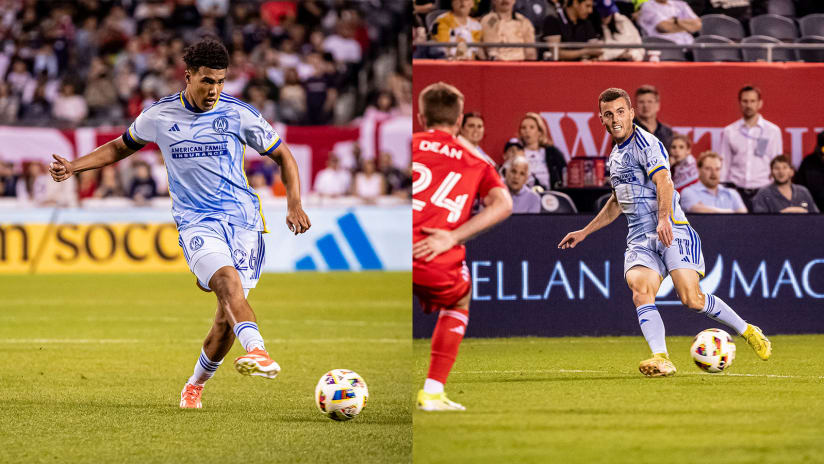As Atlanta United, and MLS, develops deeper knowledge and use of data analytics, we’ll be taking a look behind the curtain at some of the specific stats the club values. In our new weekly content series, we examine one metric provided by StatsBomb that may not stand out on a first watch, but upon closer evaluation, is a useful tool to measure the team’s performance.
Thiago Almada is used to having the ball in high-pressure situations. Now, he’s learning how to apply it.
Almada was the lone goal scorer for Atlanta United in the 2-1 loss to FC Cincinnati on April 20. Of course, we could break down the play that led to Almada’s goal, a fine curling shot that was nominated for MLS Goal of the Matchday. We could also dissect the play that most supporters were talking about after the match – Almada's pass on a short corner kick that FC Cincinnati turned over quickly into a goal of their own.
But this week, we’re taking a deeper look into an area of the match that hasn’t been talked about as much as those two plays and a side of Almada’s game that isn’t scrutinized quite as closely: how Almada plays when he doesn’t have the ball.
The World Cup winner and reigning MLS Young Player of the Year put in one of his best defensive performances in Atlanta United’s most recent match, which can be shown in a metric called pressure.
The stat: Pressure
What it means: The amount of space a defensive player gives an opponent and how it leads to a pressing trigger.
StatsBomb defines pressure to be when a player blocks a passing lane or closes down to force their opponent to turn the ball over. The metric of pressures (and counter pressures) differs from ball-winning actions, which we looked at with Tristan Muyumba a few weeks ago. Tackles and interceptions are the acts of regaining the ball from an opponent. Pressure is what might lead an opponent to make a mistake or a poor pass and turn the ball over. (In fact, the example discussed in the article, it is actually Jamal Thiaré with the pressure that led to Muyumba’s interception.)
There are certain teams that are good at applying pressure and other teams that sit back more and give their opponents space. This might be intentional or not – that’s all part of the defensive tactics. It also depends on what part of the field pressure is being applied. Obviously, the deeper the opponent gets into a defensive area, the higher the pressure. Urgency increases as the defensive team looks to stop an attack or chance from being created.
Atlanta United, as a team, is possession-based. When Atlanta loses the ball, they want to get it back as quickly as possible, so attackers should be well-positioned to be involved in defending. Head coach Gonzalo Pineda calls it “active defending,” a rough translation of marca en ataque, a phrase in his native Spanish that Pineda says better describes this idea. Basically, it means marking while in the attack and making sure players are aware of the space around them so they can anticipate opportunities to regain the ball.
Giorgos Giakoumakis spoke on this earlier this season:
“It’s really important for us that this year, defensively, we’re more concentrated, more tough. And by starting defensively with zero, then we can demand more things from your attack and from the targets that you have during the season.”
For Atlanta’s striker to say this epitomized the importance of Atlanta United improving its overall defense in 2024, not only from the team’s backline but also from the team’s attacking players, including Almada.
And it appears that Almada is making the effort. Considering the metric of pressure, Almada had 30 pressures and nine counter pressures in the match against FC Cincinnati. For pressures, that’s tied for second highest in his club career with Atlanta United. It’s the second most counter pressures he’s had in his career.
Almada has been on a strong run in this category, going back the past several matches. He’s recorded 76 pressures across his past three matches, the most he's ever had in a three-match stretch in his career. On the road against New York City FC on April 6, the Argentine midfielder reached a career high in pressures and counter pressures. This shows good effort and perhaps a better understanding on Almada’s part on what moments in a match to apply pressure.
We can take a look at three examples during the match against FC Cincinnati. In the second play, we see Almada apply pressure on his former teammate Miles Robinson which actually leads to a takeaway deep in Atlanta United’s attacking third. StatsBomb likes to use an aerial graphic to show how much space a player is given by measuring the radius to the nearest defender, which we’ve included to show some of Almada’s pressures:
Almada is already a world-class scorer, as we saw last season and with his goal in the match. Now, he’s putting in the work to develop an area of his game that he isn’t known for quite as well. It’s a good sign when one of your best players on the pitch is putting in so much effort to regain the ball back for his team.
Atlanta United's Data Scientist & Analyst Arjun Balaraman contributed to this story. Visualizations and video by Khoury Kennedy, Atlanta United's Motion Graphics Producer and Video Editor.







